Cylinder and hot water tanks
Should I have a cylinder or a combi boiler?
What are the advantages and disavantages of having a cylinder system verses a combi boiler? We can explain and help you work out what system is most suitable for your home.
Central heating systems that don't have a combi (combination) boiler with be connected to a cylinder with or without a cold feed cistern.
Cylinder
The cylinder is essentially a storage facility for hot water that is heated from the boiler and sent to the taps and shower when required. These are large cylindrical (hence the name) tanks and are most often found in the air cupboard. They are made of copper or stainless steel and, if insulated correctly, will be covered in a plastic jacket to help keep the heat in. They have a coil inside that heats up when the boiler heats the system which in turn heats the water in the cylinder to the set temperature.
Vented or unvented cylinder?
Vented Cylinder
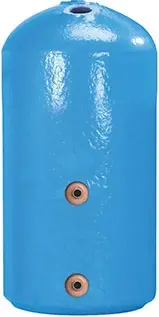 There are 2 types of hot water cylinder that you may have depending on your system.
There are 2 types of hot water cylinder that you may have depending on your system.
A vented cylinder is the traditional and most common type and is fed from a cold feed cistern above. This style of system ensures a natural and constant flow around the system and to the taps due to the gravitational pull and generally maintains good water pressure throughout. However, due to needing the water cistern above, it can limit the location of the cylinder and can have an impact on performance. For example, a house without a high roofline and loft could mean the cistern is closer to the cylinder and therefore the gravitaional force is less leading to lower pressure, especially in the upstairs taps.
These systems are the most simple to install and maintain, leading to lower costs and higher popularity.
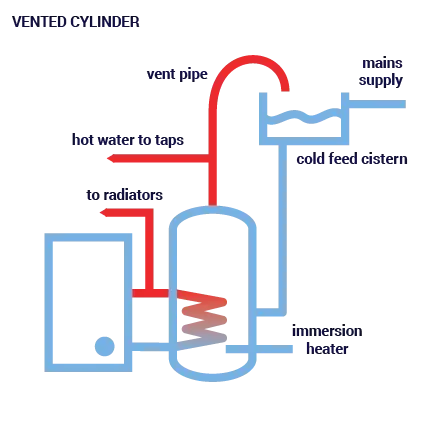
See what options are available for YOUR property here
Unvented Cylinder
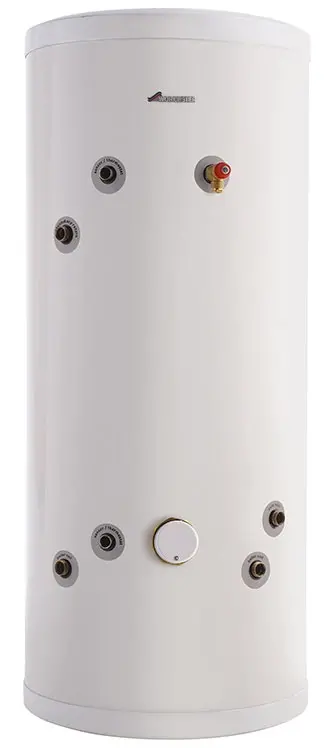 If a vented cylinder is not a suitable option for your property, the alternative option is an unvented cylinder. The difference is that no cold feed cistern is required and the water is fed directly from the mains, using the main pressure instead of gravity from the tank above. This can produce a better water pressure throughout the propeerty and to the taps and shower.
If a vented cylinder is not a suitable option for your property, the alternative option is an unvented cylinder. The difference is that no cold feed cistern is required and the water is fed directly from the mains, using the main pressure instead of gravity from the tank above. This can produce a better water pressure throughout the propeerty and to the taps and shower.
Unvented cylinders can be heated either by electricty via the immersion heater or by gas through the boiler.
Since this type of cylinder is fully sealed, they require an expansion vessel to collect the excess hot water when it expands upon heating. This is an extra feature of this type of cylinder whch means they need more specialist installation and regular maintenance leading to higher costs for installation and upkeep. However, the lack of cold feed cistern also means they can be located anywhere within the property e.g. in the airing cupboard of a house with no loft, or even in the loft itself so that it is out of sight and not taking up valuable space.
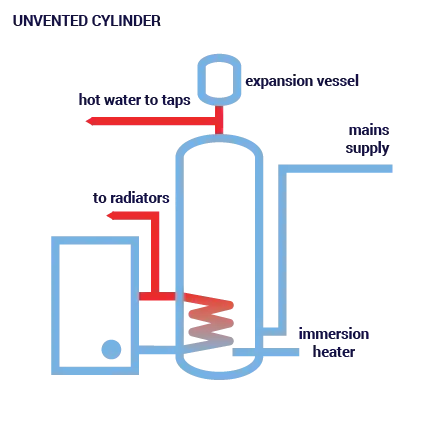
See what options are available for YOUR property here
Cold Feed Cistern
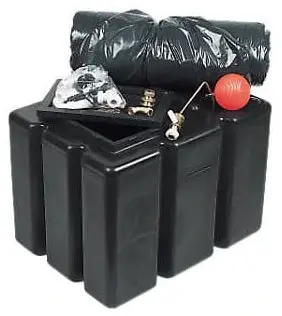 The cold feed cistern is a plastic tank, usually situated in the loft, that is filled directly from the mains water inlet to the house. This ensures there is fresh water into the system each day. The cistern in turn fills the cylinder and is heated according to the heating schedule. It is always situated in a higher location than the cylinder to allow natural gravitational force to ensure a constant flow of water. There is a ball valve inside the cistern to ensure the tank fills but does not overflow.
The cold feed cistern is a plastic tank, usually situated in the loft, that is filled directly from the mains water inlet to the house. This ensures there is fresh water into the system each day. The cistern in turn fills the cylinder and is heated according to the heating schedule. It is always situated in a higher location than the cylinder to allow natural gravitational force to ensure a constant flow of water. There is a ball valve inside the cistern to ensure the tank fills but does not overflow.
Immersion Heater
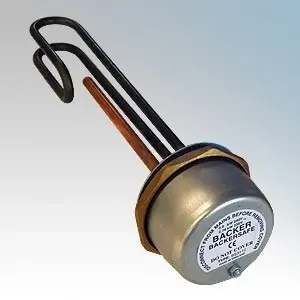 An immersion heater is a metal loop found inside the cylinder to manually heat the water inside when the central heating system is not runing. It works much like a kettle to heat the water through convection - as the heated water rises, cold water replaces it which then in turn heats up. The immersion heater is conencted to a cable and heated via electricty. This is normally controlled by a simple on/off switch located, often inside the airing cupboard, but can also be elsewhere in the property.
An immersion heater is a metal loop found inside the cylinder to manually heat the water inside when the central heating system is not runing. It works much like a kettle to heat the water through convection - as the heated water rises, cold water replaces it which then in turn heats up. The immersion heater is conencted to a cable and heated via electricty. This is normally controlled by a simple on/off switch located, often inside the airing cupboard, but can also be elsewhere in the property.
Immersion heaters are not the most cost effective way to heat your water but can be useful for a small amount of hot water, for instance, to wash up in the summer when the central heating is not being used. An average immersion heater would use approximately 3 kilowatts of electricity per hour, which would be in the range of 70p to 80p per hour. It would need to be run for a couple of hours to obtain a decent amount of water and so if used 4 or 5 times a week could amount to around £350 a year on top of your central heating bill.
For further information on our new boiler installation and boiler replacement services across , please give us a call or send us a message